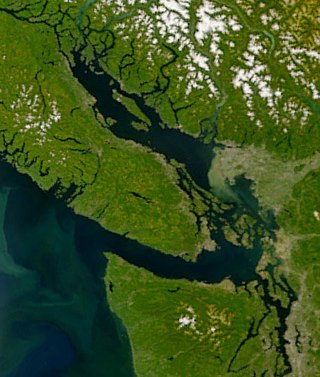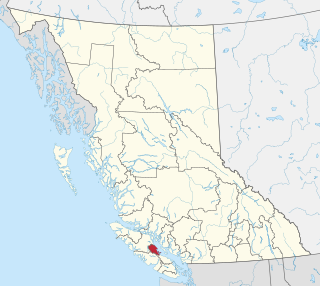
Vancouver Island is an island in the northeastern Pacific Ocean and part of the Canadian province of British Columbia. The island is 456 km (283 mi) in length, 100 km (62 mi) in width at its widest point, and 32,100 km2 (12,400 sq mi) in total area, while 31,285 km2 (12,079 sq mi) are of land. The island is the largest by area and the most populous along the west coasts of the Americas.

Highway 19 is the main north–south thoroughfare on Vancouver Island from Nanaimo to Port Hardy. It forms part of the Island Highway along with Highway 1 and Highway 19A. A highway has existed on the Island since about 1912. Originally gravel and rough, the highway was an essential link together with the Esquimalt & Nanaimo Railway. The paved highway first opened in 1953, replacing a stretch of Highway 1 between Nanaimo and Campbell River, finally being extended to the northern tip of the island in the late 1970s. The total length of the highway is 403 kilometres (250 mi).
Highway 19A, known locally as the Oceanside Route or the Old Island Highway, is a provincial highway in British Columbia, Canada. It runs along two former sections of Highway 19 on Vancouver Island, within Nanaimo and between Craig's Crossing and Campbell River. The section of Highway 19A between Craig's Crossing and Campbell River is 136.89 km (85.06 mi) long, and the Nanaimo alignment covers 10.64 km (6.61 mi). The highway was established after Highway 19 was realigned to a new road between 1996 and 2001.

Comox is a town on the southern coast of the Comox Peninsula in the Strait of Georgia on the eastern coast of Vancouver Island, British Columbia. Thousands of years ago, the warm dry summers, mild winters, fertile soil, and abundant sea life attracted First Nations, who called the area kw'umuxws.

The Kʼómoks or Kʼomoks, usually known in English as the Comox, are an indigenous group of Coast Salishan-speaking people in Comox, British Columbia and in Toba Inlet and the Malaspina Peninsula areas of the British Columbia mainland across Georgia Strait. They historically spoke the Komox language (Comox-Sliammon), and were divided in two main dialect and tribal groupings, which are known by academics as Island Comox and Mainland Comox.

The Strait of Georgia or the Georgia Strait is an arm of the Salish Sea between Vancouver Island and the extreme southwestern mainland coast of British Columbia, Canada, and the extreme northwestern mainland coast of Washington, United States. It is approximately 240 kilometres (150 mi) long and varies in width from 20 to 58 kilometres. Along with the Strait of Juan de Fuca and Puget Sound, it is a constituent part of the Salish Sea.

Vancouver Island North is a former federal electoral district in British Columbia, Canada, that was represented in the House of Commons of Canada from 1997 to 2015.

The Island Rail Corridor, previously the Esquimalt & Nanaimo Railway, is a dormant railway operation on Vancouver Island and is the only remaining railway there after the closure of the Englewood Railway in November 2017. The Island Corridor Foundation owns the former Esquimalt & Nanaimo Railway corridor. The railway line is 225 kilometres (140 mi) in length from Victoria to Courtenay, known as the Victoria Subdivision, with a branch line from Parksville to Port Alberni known as the Port Alberni Subdivision at 64 kilometres (40 mi) in length, for a total 289 kilometres (180 mi) of mainline track. In 2006, the Island Corridor Foundation acquired the railway's ownership from the Canadian Pacific Railway.

Courtenay is a city of about 26,000 on the east coast of Vancouver Island, in the Canadian province of British Columbia. It is the largest community and only city in the area commonly known as the Comox Valley, and the seat of the Comox Valley Regional District, which replaced the Comox-Strathcona Regional District. Courtenay is 4 km (2.5 mi) west of the town of Comox, 7 km (4.3 mi) northeast of the village of Cumberland, 5 km (3.1 mi) northwest of the unincorporated settlement of Royston, and 108 km (67 mi) northwest of Nanaimo. Along with Nanaimo and Victoria, it is home to The Canadian Scottish Regiment, a Primary Reserve infantry regiment of the Canadian Armed Forces.

The Regional District of Comox-Strathcona was a regional district of British Columbia, Canada from 1967 to 2008. On February 15, 2008, the regional district was abolished and replaced by two successor regional districts, Comox Valley and Strathcona.

Royston is an unincorporated community that is part of the greater Comox Valley region, 100 km northwest of Nanaimo on Vancouver Island, in British Columbia, Canada. With a population of just over 1,500, it is next to the Trent River, across the harbour from Comox, and lies on the southeast municipal boundary of Courtenay.
Black Creek is a community on the eastern side of Vancouver Island, British Columbia, Canada. It is approximately 16 kilometres (9.9 mi) north of Courtenay. It is primarily an agricultural hamlet and bedroom community to Courtenay and Campbell River - approximately 20 kilometres (12 mi) to the north. It is part of Electoral Area C in the Comox Valley Regional District.

Mount Washington Alpine Resort is a year-round recreation destination located on Vancouver Island, British Columbia, Canada. The resort is the island's only full-service ski and summer resort hosting over 250,000 visits per year. Located Mid-Island, the resort is situated more than one kilometre above sea level. It overlooks the Comox Valley, Strait of Georgia, Coast Mountains, and the Beaufort Range. Strathcona Provincial Park, BC's oldest provincial park, is a 106-kilometre (66 mi) drive from the Mount Washington Alpine Resort.
School District 71 Comox Valley is a school district on Vancouver Island in British Columbia, Canada. This includes the communities of Courtenay, Comox and Cumberland as well as the surrounding rural areas and the adjacent islands of Denman and Hornby.

Island Health, also known as the Vancouver Island Health Authority, is the publicly funded health care provider in the southwestern portion of the Canadian province of British Columbia. It was established as one of five geographically based health authorities in 2001 by the Government of British Columbia.

Claire Felicity Trevena is a Canadian politician, who represented the North Island electoral district Legislative Assembly of British Columbia from 2005 to 2020. During the 41st Parliament (2017-2020) she was appointed to the Executive Council to be the Minister of Transportation and Infrastructure. She is a member of the British Columbia New Democratic Party and was first elected as a Member of the Legislative Assembly in the 2005 election and re-elected in the 2009, 2013 and 2017 elections. In the 38th Parliament of British Columbia, she sat on the Special Committee on Sustainable Aquaculture and the Select Standing Committee on Public Accounts, as well as serving as the opposition critic on the Employment and Income Assistance ministry, followed by the critic on child care, early childhood development, and women's issues. In the 39th Parliament she acted as a deputy speaker before returning to her role as critic on the children and family development portfolio. In the 40th Parliament, she was the critic on transportation and BC Ferries and, in that role, produced a report comparing the BC Ferries system with the Washington State Ferries system and introduced the Provincial Shipbuilding Act in both 2014 and 2015 seeking to have future ferries constructed in Canada.

The Comox Valley Regional District is a regional district in British Columbia, Canada. It was created on February 15, 2008, encompassing the southeastern portions of the former Regional District of Comox-Strathcona, and centred about the Comox Valley. The partition left the new Comox Valley Regional District with only 8.4 percent of the former Comox-Strathcona's land area, but 57.9 percent of its population. The CVRD covers an area of 2,425 square kilometres, of which 1,725 square kilometres is land, and serves a population of 72,445 according to the 2023 Census. The district borders the Strathcona Regional District to the northwest, the Alberni-Clayoquot Regional District to the southwest, and the Regional District of Nanaimo to the southeast, as well as the qathet Regional District along the Strait of Georgia to the east.

MV Princess of Vancouver was a passenger vessel in the Pacific coastal service fleet of the Canadian Pacific Railway (CPR).
An electoral redistribution in British Columbia was undertaken by the BC Electoral Boundaries Commission beginning in 2014 and was formalized by the passage of Bill 42, the 2015 Electoral Districts Act, during the 40th British Columbia Parliament. The act came into effect on November 17, 2015. The redistribution added two seats to the previous total, increasing the number of MLAs in the province from 85 to 87. The electoral boundaries came into effect for the 2017 election. The next redistribution is required to occur following the 2020 British Columbia general election.


















